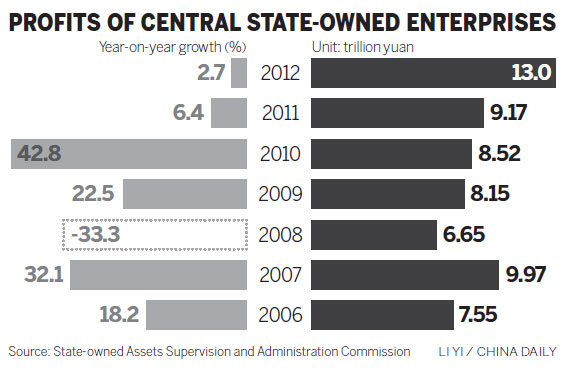Maintaining profit growth of more than 10 percent will be a very tough task for central State-owned enterprises, which will likely see their growth shrink from the third quarter, the State-owned Assets Supervision and Administration Commission has warned.
Jiang Jiemin, SASAC's chairman and former president of China National Petroleum Corp, in April required all central SOEs to guarantee at least a 10 percent profit increase for this year.

China's SOEs, which are engaged in national economic arteries including petroleum, gas, telecommunications, electronic power generation, aviation and shipping, are the pillars of the economy. An increase in their profits is considered important to stabilize the country's economy.
Last year, the total profits of SOEs rose 2.7 percent to 1.3 trillion yuan ($212 billion). A big jump from last year's figure, the requested 10 percent profit growth is considered an arduous target amid the domestic economic slowdown.
"Although the economic benefits of central SOEs will maintain a good momentum in the second half of the year, the profit growth of SOEs is predicted to slow down since the third quarter," said Liu Nanchang, director-general at SASAC's Performance Evaluation Bureau.
In the first half, the profits of SOEs increased 4.8 percent year-on-year, compared with a growth of 15.8 percent for private companies in the same period, data from the National Bureau of Statistics showed.
The low profit growth of SOEs was dragged by the weak performance of local SOEs. According to SASAC, in the first six months, central SOEs generated profits of 631.52 billion, up 18.2 percent from a year earlier.
However, the real challenge will come in the second half with factors such as financial risks and the slowdown of the domestic economy expected to affect the profit growth of central SOEs, SASAC said last week during its mid-year working conference, held in Yinchuan, in the Ningxia Hui autonomous region.
"The global financial crisis has not ended and it still affects the whole market, resulting in a distant recovery of central SOEs," said Liu.
The pessimistic forecast came as the growth of China's manufacturing sector slowed to an 11-month low this month, in the latest sign of a further slowdown of the economy.
The preliminary reading of the Purchasing Managers' Index, a main gauge of manufacturing operating activity, dropped to 47.7 in July, down from 48.2 in June, HSBC said on July 24.
"Central SOEs should be clear about which part of their business can generate more profits than last year. Market research and analysis should be done to seek new profit growth points," said Xu Baoli, a researcher at SASAC's research center.
In a move to establish reasonable evaluation standards, SASAC's Performance Evaluation Bureau is monitoring the changes in the market and the enterprises' business activities, according to Liu.
"A surplus in production capacity is still a universal phenomenon, especially in the basic material industries," said Liu.
"Inefficient assets must be liquidated, and we also encourage central SOEs to establish joint ventures with other professional companies to manage their non-core business."
"The current concentration of central SOEs is supposed to strengthen their core business and divest non-performing assets, improving business efficiency instead of scale expansion," Liu added.
This strategy is in line with the new leadership's decision to restructure the economy and focus on the quality of growth rather than on the quantity.
The government's firmness was seen last month when the central bank refrained from pumping massive amounts of cash to ease the liquidity squeeze in the interbank money market, signaling its determination to discipline the overstretched financial sector.
